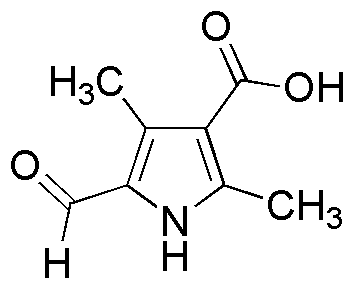5-Formyl-2,4-dimethyl-1H-pyrrole-3-carboxylic acid is widely utilized in research focused on:
- Synthesis of Pharmaceuticals: This compound serves as an important intermediate in the synthesis of various pharmaceutical agents, particularly those targeting neurological disorders.
- Organic Electronics: It is used in the development of organic semiconductors, enhancing the performance of electronic devices such as organic light-emitting diodes (OLEDs).
- Biochemical Research: Researchers employ this compound in studies related to enzyme inhibition and metabolic pathways, contributing to advancements in biochemistry.
- Polymer Chemistry: It acts as a building block in the creation of novel polymers with unique properties, useful in coatings and materials science.
- Food Industry Applications: The compound is explored for its potential as a flavoring agent or preservative, providing natural alternatives in food processing.
General Information
Properties
Safety and Regulations
Applications
5-Formyl-2,4-dimethyl-1H-pyrrole-3-carboxylic acid is widely utilized in research focused on:
- Synthesis of Pharmaceuticals: This compound serves as an important intermediate in the synthesis of various pharmaceutical agents, particularly those targeting neurological disorders.
- Organic Electronics: It is used in the development of organic semiconductors, enhancing the performance of electronic devices such as organic light-emitting diodes (OLEDs).
- Biochemical Research: Researchers employ this compound in studies related to enzyme inhibition and metabolic pathways, contributing to advancements in biochemistry.
- Polymer Chemistry: It acts as a building block in the creation of novel polymers with unique properties, useful in coatings and materials science.
- Food Industry Applications: The compound is explored for its potential as a flavoring agent or preservative, providing natural alternatives in food processing.
Documents
Safety Data Sheets (SDS)
The SDS provides comprehensive safety information on handling, storage, and disposal of the product.
Product Specification (PS)
The PS provides a comprehensive breakdown of the product’s properties, including chemical composition, physical state, purity, and storage requirements. It also details acceptable quality ranges and the product's intended applications.
Certificates of Analysis (COA)
Search for Certificates of Analysis (COA) by entering the products Lot Number. Lot and Batch Numbers can be found on a product’s label following the words ‘Lot’ or ‘Batch’.
Numéro de catalogue
Numéro de lot/série
Certificates Of Origin (COO)
This COO confirms the country where the product was manufactured, and also details the materials and components used in it and whether it is derived from natural, synthetic, or other specific sources. This certificate may be required for customs, trade, and regulatory compliance.
Numéro de catalogue
Numéro de lot/série
Safety Data Sheets (SDS)
The SDS provides comprehensive safety information on handling, storage, and disposal of the product.
DownloadProduct Specification (PS)
The PS provides a comprehensive breakdown of the product’s properties, including chemical composition, physical state, purity, and storage requirements. It also details acceptable quality ranges and the product's intended applications.
DownloadCertificates of Analysis (COA)
Search for Certificates of Analysis (COA) by entering the products Lot Number. Lot and Batch Numbers can be found on a product’s label following the words ‘Lot’ or ‘Batch’.
Numéro de catalogue
Numéro de lot/série
Certificates Of Origin (COO)
This COO confirms the country where the product was manufactured, and also details the materials and components used in it and whether it is derived from natural, synthetic, or other specific sources. This certificate may be required for customs, trade, and regulatory compliance.


